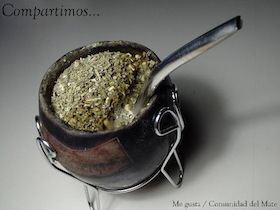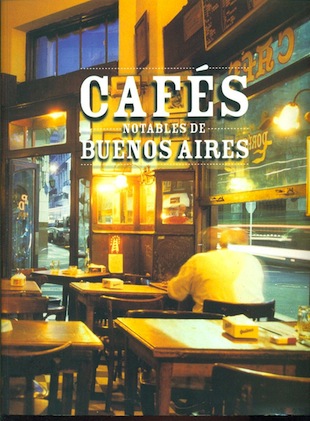LETTERS FROM THE GLOBAL PROVINCE
Sobre El Mate, Global Province Letter, 24 April 2013
"He tomado mucho mate cuando era joven. Tomar mate, para mi, era la forma de sentirme criollo viejo. Me lo cebaba yo mismo y creo que lo haca muy mal porque siempre haba flotando unos palitos sospechosos. Tena dos mates, uno comn, y otro de los que se llaman galleta. Y ahora, caramba, he perdido el hbito. "
"I have taken a lot of mate when I was young. Drinking mate, for me, was the way to feel old Creole…. and now, gosh, I've lost the habit. "
-- Jean Luis Borges, Sobre el Mate
The Café Life in Buenos Aires. There’s such an assortment of delights in Buenos Aires, as long as you are not put off by the eccentric demands of the Argentine imagination. The old architecture, patterned after a Europe of yesteryear, transports the viewer outside South America into a mythical land spun out of some novelist’s fantasies. Certain of the dance halls in the heart of town, right at the end of the workday, find 20 or 30 bourgeoisie just sprung from their office jobs, prancing through the stylized movements of the tango, even before they retreat home for the evening.
Most entrancing for us are the cafes, very unlike the coffee houses offered by the developed nations of the West which are frequented by those who are hurried even when sitting still. As we have testified, we have easily spent 2 or 3 hours at a time at La Biela, a wonderful establishment just a stone’s throw from the Alvear Hotel where we are prone to stay, and even closer to the cemetery where Eva Peron, almost beatified in Catholic Argentina, has been put to rest. The conversation is so abundant amongst the patrons, the wait staff, and passersby, such that those from other parts of the globe taking a respite at the cafe find themselves engaged with the locals in bemused chitchat.
It is one of many old cafes celebrated in Cafes Notable de Buenos Aires, a handsome publication of the local city government, which provides the reader with a look at the many best gathering places to be had. As we remember, we discovered this hard-to-find book at one of the cafes—Clasica y Moderna. Even the newer cafes, such as one we frequented in Palermo, often house very pleasant bookstores
 Mate. Deeper in the heart of Argentina is the drinking of mate (or maté), made from a semi-robust tree that some would liken, we think incorrectly, to tea plants. Mate drinking is a custom, almost a ceremony, that flourishes in broad swathes of Argentina, Brazil, Paraguay, and Uruguay. The biggest producer is actually Brazil, though somehow in our minds the Argentines own the concept and bring a certain elegance to their consumption. In Central and North America it is not at all well known, and, as we will discover later, even inspires a little disdain from Northern audiences. Sadly, the literature about mate is spotty, so it is not that easy to find out about its history, production and harvesting, preparation, and social meaning.
Mate. Deeper in the heart of Argentina is the drinking of mate (or maté), made from a semi-robust tree that some would liken, we think incorrectly, to tea plants. Mate drinking is a custom, almost a ceremony, that flourishes in broad swathes of Argentina, Brazil, Paraguay, and Uruguay. The biggest producer is actually Brazil, though somehow in our minds the Argentines own the concept and bring a certain elegance to their consumption. In Central and North America it is not at all well known, and, as we will discover later, even inspires a little disdain from Northern audiences. Sadly, the literature about mate is spotty, so it is not that easy to find out about its history, production and harvesting, preparation, and social meaning.
The most pleasant overview we have found on mate is an essay issued by the Pan American Union in 1916 called “Yerba Mate: The Tea of South America.” We learn there that mate properly is the Spanish word for gourd from whence celebrants sip the potion. The term mate, however, has come to refer to the drink and the whole drinking ceremony. Yerba refers to the plant, even though once again, most call the tea or plant—mate as well. This delightful article goes into many other particulars—the growing of mate, the preparation of the drink, etc.
The Mate Ceremony. Mate drinking at its best is a fine social experience. One gourd is passed around, the beverage sipped out of the leaves with a bombilla straw that has a filter at the bottom so that the liquid alone can be sipped, the leaves staying in the gourd. The server keeps refilling the gourd with hot water after each participant drains the vessel. The gourd never is set down but passed back and forth from hand to hand. A short essay on Yerba Mate—Background and Preparation briefly outlines both the ritual and the ostensible benefits of mate.

“Mate is exactly the opposite of television it makes you converse if you are with someone and it makes you think when you are alone.”
We would claim, however, that the central benefit of mate is social, the sharing of the drinking experience out of a common gourd and the melding of personalities that occurs as the mate is sipped. In this, it has been pointed out to us, the mate culture is far different that the tea drinking of the Far East. There, it is all about the tea making process, the ceremony, the tea. In Argentina it is about the people relaxing and coming together. Oddly, though mate is often drunk in the most basic of circumstances, it is infused with more intimacy that the coffee doings at the sublime cafes where the conversation is more gossipy, less familial.
Argentina Under Stress. A recent article, “An Argentine Tradition Threatens to Crumble with City Architecture,” talks about the breakdown of the Buenos Aires subway and of the tender estate of that city’s infrastructure. Sadly it symbolizes the slow painful descent of this beautiful country, a process that has been underway since the beginning of the 20th century.
The wonderful people of Argentina have not been unaffected by the decay, both in their purses and their hearts. The tensions of the population are fully equivalent to those in the Western democracies where rates of mental depression are rising at epidemic rates. It is heartening that city cosmopolitans have cafes in which to blow off steam and that the gaucho cowboys carry their own special mate gear so that they can take ceremonial breaks from their own nest of anxieties.
As we have said before, the Argentines are the most analyzed people on earth. There is even a section of Buenos Aires that is called Villa Freud. In recent times, the slaughtering of innocents by military regimes would alone leave a legacy of pain that not even Freud could exhume. As an Argentine doctor has said to us, “In Argentina, everybody sees a therapist. It is a way of life.” That said, we are glad there is mate for the masses, for the people who cannot afford analysis. We in North America surely need our own mate. Technology, politics, hyperbolic discourse, and straitjacketed lives have put us asunder. Anything, anything, to pull us together.
P.S. When next in Argentina, we hope all will visit the Mate Museum in Tigre. Clearly it will set one to sipping.
P.P.S. Mate drinking is still foreign enough to America that the everyday citizen still will regard it with fear, disdain, and distrust. A Buenos Aires correspondent remembers the stare of a chap at Yosemite for us:
I should mention a brief anecdote. While I was living in the U.S., I went for a short trip with my wife, to Yosemite Park. We stopped at a gas station, and I was there sitting at a bench, next to a public phone. I started preparing a mate, with my package of yerba and the other utensils. There was this guy in the line for the public phone who stared at me. His look had a flashing sign, "I want to ask you". He finally mustered some courage, and asked what (the hell) was that. I gave my best explanation as a kind of infusion (tea) that is typical from Argentina, quite tasty. While he moved forward to keep his place in the line, he said, sotto voce, "Yeah, sure..."
P.P.P.S. While in the Tar Heel State the other day, we staged a mate ceremony for our guest, a Carolinian originally from Wilson. As a boy his father sent him out into the tobacco fields for picking. He made his first dollars then. The highest paid laborer was a woman who got extra for knowing exactly when to turn the leaves to dry. As we drank mate, he had a Proustian moment because the taste and texture of the mate reminded him of the smells of the tobacco shed where he once worked. Mate put him in the tobacco days of some 40 years ago.
P.P.P.P.S. This past year we have come more into contact with the Latin concept of sobremesa—that extended conversation perhaps with an apertif or perhaps with mate—that properly follows a meal. Maybe it is short, maybe it lasts 3 hours. Our first experience of sobremesa dates back to early times—that long twisting conversation at the long table one would have at the best of college meals. For us mate and sobremesa are related experiences.
Home - About This Site - Contact Us
Copyright 2013 GlobalProvince.com
